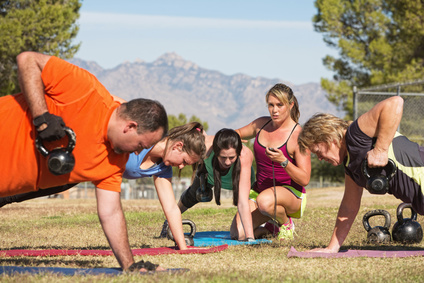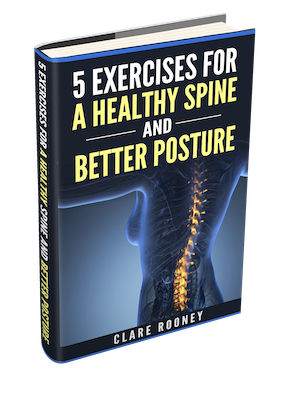The Pros and Cons of Boot Camps and Group Exercise

The Pitfalls of Low Fat Dieting
January 14, 2016
The Psychology of Fat loss
January 14, 2016The Pros and Cons of Boot Camps and Group Exercise

Instructor holding stopwatch while teaching bootcamp fitness
Exercise in the modern world could be more accurately aligned to the Fashion industry than to Science. Instead of looking at what works based on Science and years of research many people choose an exercise modality based on what is fashionable and trending right now. What’s trending right now in the fitness industry are Boot Camps and group exercise programs like Cross fit.
What do you need to know before you sign up for such a class? You need to look at the Pros and Cons of the given system in question and see if it’s right for you. So in today’s blog I am going to address this issue so that you the Public can make an informed choice rather than a fashionable choice.
Benefits:
1: Cost effective:
Training in a group setting is a lot cheaper than private coaching so you can save money.
2: A sense of community:
You can develop a real sense of belonging and support in a group setting which many people are missing out on in the modern world.
3: Motivation.
If the people in your group are working hard you can be motivated to step things up a gear. You will probably work a lot harder than if you were left to your own devices.
Downside:
1: No individualisation.
If you sign up for a Boot camp , or Cross fit or some other Group Class you show up and simply do what everybody else is doing on a given day. The problem with this is that it is extremely hit and miss. You are not the average of all of the people in the group. You are completely unique. You have many characteristics that make the program you require totally different from everybody else in the group. The factors that need to be considered are for example;
Age, Training age, Gender, Fibre Type, Flexibility, Stability, Structural Balance, Work capacity and more…..
“Programs of the future will be completely individualised. This will promote optimal training adaptations. Individual differences in the magnitude of an adaptational response to a given exercise stimulus support the need for individualised programs.”
Fleck and Kraemer, Designing Resistance Training Programs.
- Increased Risk of Injury.
The Boot camp setting is very appealing to the novice, inexperienced or overweight trainee. The promise of rapid results is very tempting. The problem however arises when this novice or deconditioned trainee dives straight into a full on intensive regimen without any idea of their capacity to stabilise the weight correctly or even move their bodies through a full and effective range of motion. What is their movement strategy like? Is the person pulling all of the work out their lower back when deadlifting for example?
I have yet to asses a new client with excellent Biomechanical Balance, heck Pro athletes struggle to achieve this! Hence injury rates can be high. So if a Pro athlete who is genetically gifted and training under supervised conditions ( usually with a highly qualified coach) has a challenge in achieving that balance where do you think that leaves Ms Jones who walks in off the street and signs up for some training?
I just assessed a client last week with a 30 degree curvature in her Lower Back and a dysfunctional Lumbo-Pelvic Rhythm. If she had signed up for a group exercise class the chances of her creating a serious injury were very high indeed. Thankfully she was smart enough to know that individualised assessment and guidance was the way to go for her.
How many of these group exercise classes thoroughly biomechanically assess their trainees? Answer- almost NONE.
- Intensity versus Productivity
Many trainees like these group classes because they “Feel Hard” they “Feel Intense” so therefore they must be working right?
Dr Fred Hatfield , aka Dr Squat , former World Powerlifting Champion and one of the first men to squat over 1000lb in competition calls this the “ I feel it syndrome”. Just because it feels hard does not necessarily mean you will make progress. Charles Poliquin has also given a fantastic example of the “I feel it syndrome” with his analogy of fly swatting. If you grab a fly swatter and do thousands of swipes with it your heart rate will go up and it will feel fairly intense. For many reasons strangely this will not turn you into a mega ripped Adonis.
In order for a workout to be productive the science of resistance training needs to be in place. Correct exercise selection, Correct exercise order, Correct load selection, Reps, Sets, Tempo and Periodization of the training all need to be taken into account. Unfortunately many of the group exercise programs available today have no scientific basis and no structure to the program design. Exercises are randomly thrown together . This is an absolute abomination of what resistance training could be. It could be an opportunity to get Stronger, Leaner and add some life extending tissue to your life! Yes folks that’s what muscle is…a life extending tissue that has a snowballs chance in hell of growing with random slapped together routines that do not take into account the factors mentioned above.
So it’s a case of buyer beware! Before you sign up make sure know what you are getting yourself into. Get yourself biomechanically assessed, know your weaknesses, know what your strategy is to overcome those weaknesses and only get involved with a group exercise program where the trainer knows all of this information about you and he or she can explain clearly the strategy behind their program design and make appropriate modifications for you.




